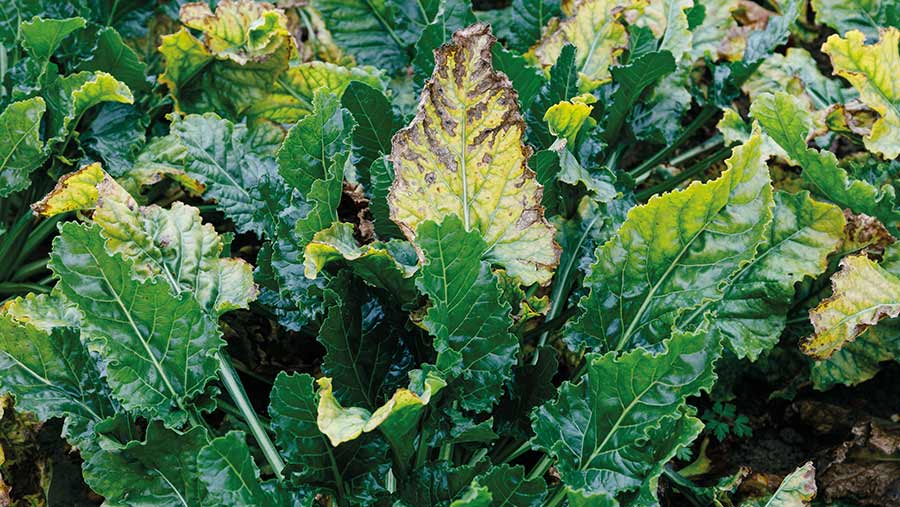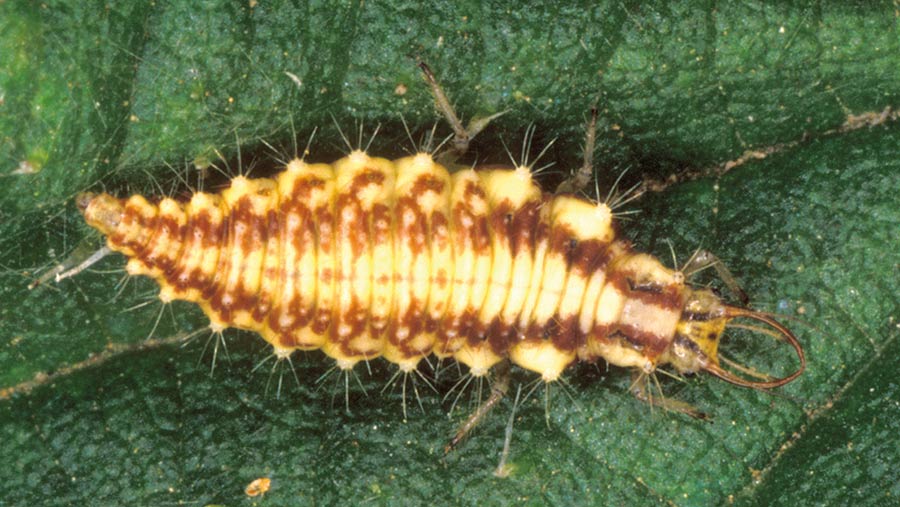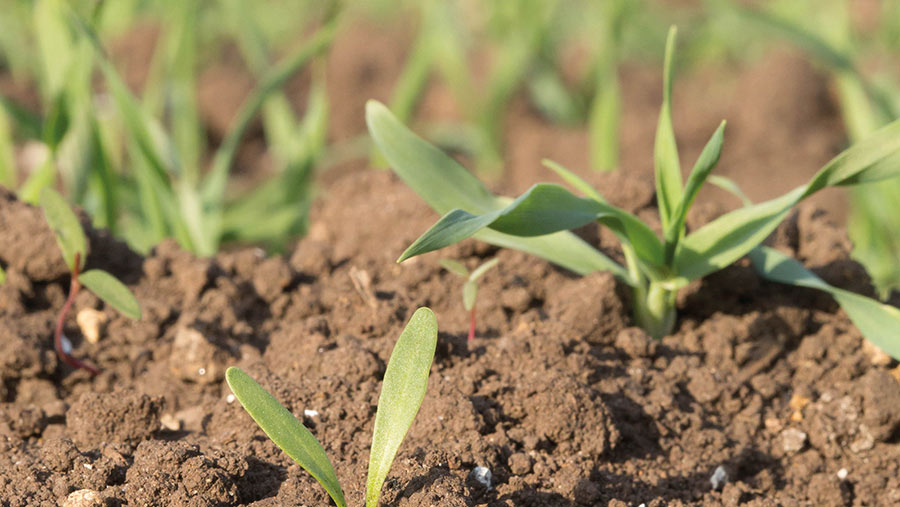Could beneficial insects help fight against virus yellows?
 © Blackthorne Arable
© Blackthorne Arable In the hunt for new solutions to virus yellows in sugar beet, research into whether biological control can help is being ramped up on a Cambridgeshire farm this season.
An initial look-see, inoculating half of a 14ha field with beneficial insects at Tom Clarke’s farm near Ely, Cambridgeshire, provided enough promise that the trials are not just being repeated, but scaled up for the coming season.
See also: Video: How a US potato grower is slashing pesticide use
Virus yellows, which caused devastating yield losses of more than 50% on some fields last season, is transmitted when the peach potato aphid (Myzus persicae) feeds on the crop.
Natural biological control of aphids will occur in the field through predation once populations have built up, but this typically occurs too late to provide useful control of virus yellows.

The larvae of the green lacewing are voracious feeders on aphids © Keith Wheeler/Science Photo Library
That is why in these trials, which are being overseen this year by the British Beet Research Organisation (BBRO), one of the main aims is to have populations of beneficial predators already in place when the aphid migration is due, explains Mr Clarke.
To achieve this, the trial will release predatory lacewing larvae (Chrysoperla carnea), together with spreading sterilised moth eggs as a food source. Both are produced by the biological control company Bioline AgroSciences.
Bioline breeds lacewing larvae for release by feeding them on sterilised moth eggs. The eggs are perfect protein packets of food for carnivorous insects, which don’t deteriorate, says Mr Clarke.
“So, as well as feeding them in the factory and shipping out the resulting lacewing to the farm, we’re going to also try spreading those moth eggs in the field to supply food for both pre-existing predatory insects in the field and support introduced insects as well.”
The plan is to have a resident population of both native and introduced predatory insects in the field, ready to wipe out the aphids as they arrive.
Parasitic wasp
A second approach will repeat that treatment, but with the addition of a parasitic wasp, Aphidius colemani, which stings and lays its eggs inside the aphid, killing it within a couple of days.
Biological strategies being tested
- Introduction of lacewing larvae that predate peach potato aphids
- Spreading moth eggs to feed both introduced lacewing larvae and existing beneficial insects
- Introducing parasitic wasps to lay eggs in peach potato aphids
With Rothamsted’s virus yellows forecast suggesting first aphids will arrive in crops from about 18 May, there will be more time to build that population this season than in 2020, when aphids were found in sugar beet crops by the end of March. “About two weeks lead time is required to allow establishment of beneficial populations ahead of aphid migrations,” suggests Mr Clarke.
Caroline Reid, senior technical lead for Bioline AgroSciences in northern Europe, adds a little more detail to the trial layout, which is likely to have a mid-April drilling date. That will be Mr Clarke’s latest-drilled field and, therefore, most at risk this season.
Dr Reid is comparing introduced lacewing larvae at a rate of 2/sq m with another introduction of the same rate of lacewing larvae with 0.5/sq m of the parasitic wasp.
Each approach will be repeated three times in large-scale plots on 18m tramline widths to improve statistical analysis.

The study will also look at the effectiveness of a nurse crop of barley drilled before the beet © Tim Scrivener
“The control treatment will be the farm standard foliar insecticide programme,” says Dr Reid.
Sterilised moth eggs will be applied at the same time as the biocontrols, with a follow-up application of moth eggs to provide extra food planned for two weeks after the initial release.
The lacewing larvae will be spread by hand, while Mr Clarke is planning to broadcast the moth eggs with an Amazone pneumatic spreader, as they are more robust.
Nurse crop
“There will also be a barley nurse crop drilled before the beet crop, which we think will be a good carrier for the moth eggs,” he says.
Practicality and cost-effectiveness are important, acknowledges Georgina Barratt, who is leading the project for the BBRO.
“We know it works effectively in glasshouses, but there are a lot of unknowns, as most of our information is based on that setting and we don’t know how it compares to the field.
“I have faith it will work in the field, but it needs to be practical and cost-effective, not least because of the challenges growers face with production costs.”
If the trial is successful this season, follow-up trials using lower rates of predators with more food are likely to be carried out to help reduce costs, she suggests.
A baseline assessment of aphid population will be made before the trial starts, with further counts at three to five days and 10-12 days after lacewing larvae are introduced, she says. “We’ll also have monthly drone flights to help assess virus yellows levels across the field.”
The drones will help map virus spread across the field, which is likely to be patchy given that it will be a natural inoculation and with the lower forecast this season. “Mapping will help us understand whether the lacewings have had an effect on the virus, based on where it occurs in the field.”
Aphids collected from the field will be tested for presence of virus, while yield digs across four areas in each treatment will also be carried out and then tested for sugar content and other tarehouse analyses.
Similar trials are being carried out on small plots in France in partnership with Bioline, with the results being shared, Dr Barratt adds. “It allows us to bring our knowledge together to see what is working or not.”
Other BBRO research into virus yellows
- Varietal resistance A continuation of the Goliath project, which will investigate both new varieties and, this year, all the 2022 Recommended List varieties for resistance to virus yellows. In addition, BBRO will examine the effect of different plant ages at the point of infection with virus
- Aphicides Further research into both chemical and biological options
- Barley nurse/cover crops More in-depth studies to investigate whether anecdotal reports can be quantified of less virus where barley nurse crops were planted last season
- Other beneficials Replicated trials examining alternative aphicide strategies including the release of beneficials
- Host plants Potential of autumn-sown wildflower strips to host beneficials
- Natural repellents Use of endophyte grasses from New Zealand, which produce alkaloid compounds toxic to some pests. Could these be released and taken up by sugar beet plants as the grasses decompose, and so reduce aphid feeding?
Beneficial insects at a glance
Green lacewings (Chrysoperla carnea)
- The larvae are voracious predators of aphids and other small, soft-bodied insects.
- Adults hunt for aphid colonies and lay eggs nearby, then the larvae remain in place and feed on the aphids
- One larva can consume up to 200 aphids
Parasitic wasp (Aphidius colemani)
- This species is a highly effective hunter, flying throughout the crop to find aphid hosts
- A female can parasitise about 300 aphids in her lifetime
- Parasitism is manifested by immobility and swelling of the aphid, which eventually turns into a “golden mummy”
- Once parasitised, the aphid quickly becomes harmless to the plant four to seven days after mummification. The wasps then seek out new hosts
Source: Bioline AgroSciences

